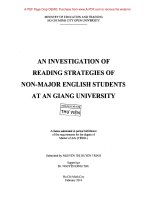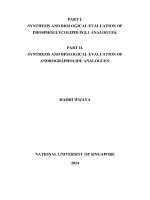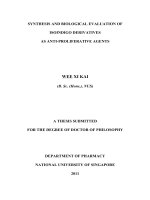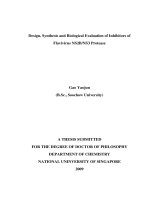Volatile compounds and biological activities of essential oil of globba pendula rhizomes collected at An Giang province
Bạn đang xem bản rút gọn của tài liệu. Xem và tải ngay bản đầy đủ của tài liệu tại đây (539.3 KB, 8 trang )
Vietnam Journal of Science and Technology 58 (4) (2020) 434-441
doi:10.15625/2525-2518/58/4/14856
VOLATILE COMPOUNDS AND BIOLOGICAL ACTIVITIES OF
ESSENTIAL OIL OF GLOBBA PENDULA RHIZOMES
COLLECTED AT AN GIANG PROVINCE
Ngo Thi Phuong1, Dinh Thi Thu Thuy1, Do Thi Thao2, Do Thi Thanh Huyen1,
Le Ngoc Hung3, Nguyen The Anh4, Le Minh Ha1, *
1
Institute of Natural Products Chemistry, Vietnam Academy of Science and Technology (VAST),
18 Hoang Quoc Viet, Cau Giay, Ha Noi, Viet Nam
2
Laboratory of Bioassay, Institute of Biotechnology, VAST, 18 Hoang Quoc Viet, Cau Giay,
Ha Noi, Viet Nam
3
Pharmaceutical Chemistry Lab Project, Center for Research and Technology Transfer, VAST,
18 Hoang Quoc Viet, Cau Giay, Ha Noi, Viet Nam
4
Institute of Chemistry, VAST, 18 Hoang Quoc Viet, Cau Giay, Ha Noi, Viet Nam
*
Email:
Received: 26 February 2020; Accepted for publication: 17 June 2020
Abstract. The present paper describes chemical composition, NO inhibitory activity against
lipopolysaccharide (LPS)-induced nitric oxide release, cytotoxic activity against MCF7 and
Hep3B cell lines of the essential oil of Globba pendula Roxb. rhizomes. A total of 25
components of the essential oil were identified by using gas chromatography–mass spectrometry
(GC-MS), accounting for 89.55 % of the total oil. -selinen (36.45 %) and ishwarane (10.76 %)
were the main components. The essential oil was found to possess moderate NO inhibitory effect
with IC50 of 41.68 ± 4.51 µg/ml, and significant cytotoxic activity against MCF7 and Hep3B cell
lines with IC50 of 28.15 ± 1.08 and 35.24 ± 0.06 µg/ml, respectively. This is the first report on
volatile compounds and biological activities of the essential oil of Globba pendula Roxb.
rhizomes collected in An Giang province, Viet Nam.
Keywords: Globba pendula, cytotoxic activity, NO inhibitory activity, essential oil, GC-MS.
Classification numbers: 1.1.3, 1.2.1.
1. INTRODUCTION
Globba pendula Roxb. (called “Ngải mọi” in Viet Nam), a herb belonging to the genus
Globba (Zingiberaceae), is endemic in Indochina [1]. In folk medicine, the rhizomes of G.
pendula are used to treat rheumatism and osteoarthritis. In Malaysia, people use the decoction of
the rhizomes for postpartum women and deworming. In Indonesia, it has been used to treat the
flatulence [2, 3]. However, just only one report on chemical constituents presented the isolation
and structural identification of ten compounds including labdane diterpenes and benzofurans [4].
Volatile compounds and biological activities of essential oil of Globba pendula rhizomes …
Up to date, no report on biological activities of the plant has ever been published worldwide.
Essential oils are oily, hydrophobic, aromatic, and volatile liquids that can be extracted from
natural sources, usually plants [5]. Essential oils are valuable plant products, which are used as
therapeutic agents in ethno, conventional, and complementary alternative medicines. Particularly
they have analgesic, anti-inflammatory, antispasmodic, local anaesthetic, anthelmintic,
antipruritic, and antiseptic as well as many other therapeutic uses and they contribute many
disease control benefits [6]. It is worth noting that there has been no research on the essential oil
of G. pendula. Therefore, it is necessary to investigate the chemical composition and biological
activities to clarify uses of G. pendula rhizomes in folk medicine. In the current paper, we
present the results of screening chemical composition by GC-MS analysis and assaying
cytotoxic activity, and inhibitory effects on LPS-induced NO production in RAW264.7 cells of
the essential oil from the rhizomes of G. pendula.
2. MATERIALS AND METHODS
2.1. Chemical and biological materials
Lipopolysaccharides (LPS) from Escherichia coli were purchased from Sigma Chemical
Co. (St. Louis, MO, USA). Dulbecco’s Modified Eagle’s Medium (DMEM), fetal bovine serum
(FBS) were obtained from Life Technologies, Inc., (Gaithersburg, MD, USA). Sodium nitrite,
sulfanilamide, N-1-napthylethylenediamine dihydrochloride and dimethyl sulphoxide (DMSO)
were obtained from Sigma Chemical Co. (St. Louis, MO, USA). Other chemicals were
purchased from Sigma, GIBCO, Invitrogen, Promega. The murine macrophage cell line (RAW
264.7) was obtained from Prof. Domenico Delfino, Perugia University, Italy.
Human breast carcinoma cell line (MCF-7) and human hepatoma cell line (Hep3B) were
obtained from Prof. Jeong-Hyung Lee, Kangwon National University, Korea.
2.2. Plant material and preparation of the essential oil
The fresh rhizomes of Globba pendula Roxb. were collected in An Giang province, Viet
Nam in February 2019 and were identified by Dr. Nguyen Van Du, Institute of Ecology and
Biological Resources, Vietnam Academy of Science and Technology (VAST). The voucher
specimens (NGM-02.2019) were deposited in the Pharmaceutical Chemistry Laboratory,
Institute of Natural Products Chemistry, VAST.
The fresh rhizomes (500 g) of G. pendula were washed with water, chopped and
hydrodistilled using Clevenger apparatus for 6 hours to give the raw essential oil. The oil was
then dried with anhydrous sodium sulphate (Na2SO4) to remove the remaining water trace. The
obtained essential oil (2.6 g) was then used to analyze chemical composition and evaluate
biological activities.
2.3. GC-MS analysis
GC-MS analysis of the essential oil was carried out on an Agilent Technologies HP7890A
GC equipped with a mass spectrum detector (MSD) Agilent Technologies HP5975C and a HP5MS column (60 m × 0.25 mm, film thickness 0.25 µm, Agilent Technologies). The injector and
detector temperatures were set at 250 and 280 oC, respectively. The column temperature
progress initiated at 60 oC, followed by an increase to 240 oC at 4 oC/min. The carrier gas was
helium at a flow rate of 1 mL/min. The sample was injected by splitting. The split ratio was
435
Ngo Thi Phuong, et al.
100:1. The volume injected was 1 µL of essential oil. The MSD conditions were as follows:
ionization voltage 70 eV, emission current 40 mA, acquisitions scan mass range 35-450 amu
under full scan. A homologous n-alkane series was used as the standard to calculate retention
time indices (RI) of each component. The relative amounts of individual components were
calculated based on the GC peak area (MSD response) without correction. MassFinder 4.0
software connected to the HPCH1607, W09N08 libraries, and the NIST Chemistry WebBook
was used to match mass spectra and retention indices. To confirm these results, further
comparison was made with data of authentic compounds reported in the original literature.
2.4. Assay for NO inhibitory effect using RAW264.7 cells
Cell culture
RAW264.7 cells were cultured in DMEM containing 10 % fetal bovine serum, 2 mM
glutamine, 10 mM HEPES, 1 mM sodium pyruvate. Cells were grown after 3 - 5 days with the
ratio of 1:3 at 37 °C, 5 % CO2 in fully humidified air. The assay was performed at Bioassay
Group, Institute of Biotechnology, VAST.
Inhibitory activity on NO production assay
RAW264.7 cells were initially grown in 96-well plate (2 × 105 cells/well) and incubated in a
humidified atmosphere with 5 % CO2 at 37 oC for 24 hours. After that, the medium was removed
and replaced by DMEM (free FBS) for 3 hours. The cells were treated with sample for 2 hours
followed by 1 µg/mL of LPS treatment for 24 hours. The nitrite accumulated in culture medium
was measured as an indicator of NO production based on the Griess reaction. Briefly, 100 µl of
culture medium were incubated with 100 µl of Griess reagent (50 μL of 1 % (w/v) sulfanilamide
in 5 % (v/v) phosphoric acid and 50 μL of 0.1 % (w/v) N-1-naphthylethylenediamine
dihydrochloride in water) in a 96-well plate, incubated at room temperature for 10 min [7]. After
incubation the absorbance was determined using an ELISA reader at 540 nm. The DMEM (free
FBS) medium was used for blank-reading in all experiments, and the positive control was NGMethyl-L-arginine acetate (L-NMMA). Standard calibration curves were prepared using sodium
nitrite as standard. The inhibition percentage was calculated by the Eq. (1):
(1)
in this equation, I is the inhibition percentage (%), NOsample and NOLPS are the concentrations of
NO produced when using studied sample and negative control, respectively. The assay was
repeated three times to ensure accuracy. The IC50 values were identified using Table Curve
2Dv4.
MTT assay for cell viability
To evaluate the cytotoxic effect of sample in RAW 264.7 cells in the assay condition, MTT
assay was performed. Briefly, cells were treated with studied sample in 96-well plate in a
humidified atmosphere with 5 % CO2 at 37 oC for 72 hours then added 3-(4,5-dimethylthiazol-2yl)-2,5-diphenyl tetrazolium bromide (MTT). After 4 hours of incubation, the medium was
discarded and the formazan blue formed in the cells was dissolved in DMSO. The optical
density (OD) was measured at 540 nm. The percentage of cell viability (P) was calculated by the
Eq. (2):
436
Volatile compounds and biological activities of essential oil of Globba pendula rhizomes …
(2)
2.5. Cytotoxic evaluation procedure
MTT assay, as previously described by Skehan et al. [8] was performed to assess the
cytotoxicity of essential oil of G. pendula. The cells were cultured in RPMI-1640 or DMEM
medium supplemented with 10 % foetal bovine serum (FBS), 100 U/ml penicillin and 100
μg/ml streptomycin, incubated in a humidified atmosphere with 5 % CO2 at 37 oC for 48 h.
After that, the cells were plated in a 96-well microtiter plate (2.5 × 104 cells/well) and cultured
for 24 h. The cells were then treated with the studied sample dissolved in dimethyl sulfoxide
(DMSO) at different concentrations. After 72 h of incubation at 37 oC, 5 % CO2, 20 μL MTT
reagents (5 mg/mL) were added to each well and incubated at 37 ºC for a further 4 h. Then the
medium was removed and the precipitate formazan dissolved in isopropanol. The absorbance
was measured at 570 nm. Camptothecin was used as positive control. CS (%) (% cell survival)
was calculated by the Eq. (3):
[
]
(3)
∑
σ (standard deviation) was calculated by the formula: √
(4)
in this equation, is the OD value at well number i, is the mean OD value, is the number of
repeated wells. Sample with potential activities (CS50 ≤ 50 % ± σ) will be selected for the next
step test to determine IC50 value.
3. RESULTS AND DISCUSSION
3.1. Chemical composition
The yield of the essential oil of fresh rhizomes of G. pendula was 0.52 % based on the fresh
weight of the sample. A total of 25 components of the essential oil were identified by using GCMS method, accounting for 89.55 % of the total oil. The two main components were -selinene
(36.45 %) and ishwarane (10.76 %). 14 of the 25 compounds were identified as
sesquiterpenoids, corresponding to 72.63 % of the whole oil, while 6 of the 25 constituents were
monoterpenoids (6.81 % of the essential oil). Aromatic compounds and other components were
6.52 and 3.59 %, respectively. Sesquiterpenoids were also found to be the main class in the
essential oils of several Globba species such as G. sessiliflora (95.0 %), G. schomburgkii
(72.9 %), and G.ophioglossa (64.3 %) [9, 10].
-selinene is a member of the class of compounds known as eudesmane, isoeudesmane or
cycloeudesmane sesquiterpenoids with a structure based on the eudesmane skeleton. -selinene
can be found in all spice, lovage, and wild celery, which makes it a potential biomarker for the
consumption of these food products [11]. Ishwarane belonging to sesquiterpenoid class was first
isolated from the plants Aristolochia indica and Cembopentalum penduliflorum. It has been
isolated from the essential oils of Bixa orellana, Corallocarpus epigaeus and Piper fulvescens
[12]. Ishwarane exhibited antifungal activity against C. albicans and C. cladosporioides [12, 13].
However, -selinene and ishwarane have not been seen in other Globba species. Therefore, these
two compounds may be biomarkers for the identification of G. pendulafrom Globba species.
437
Ngo Thi Phuong, et al.
24.19
[1907300902] TIC #1
4.0e6
3.0e6
10.00
20.00
30.00
40.00
Figure 1. GC-MS chromatogram of the essential oil.
Table 1. Chemical constituents of the G. pendula essential oil.
No RIExp
1
1040
2
1169
438
3
4
5
6
7
8
1187
1246
1297
1348
1415
1421
9
10
11
12
13
14
15
16
17
18
1436
1446
1459
1461
1466
1474
1492
1506
1515
1524
RIa
1031
1162
1169
1239
1296
1349
1399
1410
1419
1437
1443
1445
1450
1473
1467
1485
1494
1493
Chemical name
1,8-Cineole
Isoborneol
Borneol (endoBorneol)
Isobornyl formate
3-Thujyl acetate
α-Terpinyl acetate
Cyperene
α-Gurjunene
E-Caryophyllene (=βCaryophyllene)
γ-Elemene
Guaia-6,9-diene
Cubeb-11-ene
Spirolepechinene
Drima-7,9(11)-diene
Ishwarane
Germacrene D
Bicyclogermacrene
-Selinene
%b
0.17
2.31
0.74
2.72
0.44
0.43
5.46
0.58
0.96
0.89
1.35
1.75
1.68
3.58
10.76
2.08
4.47
36.45
44.95
45.00
46.02
37.36
40.97
32.94
31.92
32.38
35.00
41.84
42.06
30.14
31.17
28.20
28.12
25.00
26.99
27.20
25.29
25.79
25.94
22.65
18.57
16.87
15.00
20.98
21.46
21.77
22.16
22.25
22.41
15.14
12.54
13.16
8.38
5.00
23.66 23.60
23.94
1.0e6
29.35
29.91
20.59
20.79
23.22
2.0e6
Volatile compounds and biological activities of essential oil of Globba pendula rhizomes …
19
20
21
22
1576
1656
1719
1792
1563
1602
1671
1740
23
24
25
1809
2004
2156
1760
1993
2092
E-Nerolidol
α-Corocalene
Daucalene
Oplopanone
(E)-Ethyl pmethoxycinnamate
Ethyl palmitate
Benzyl Cinnamate
Total identified
Monoterpenoids
Sesquiterpenoids
Aromatic compounds
Others
2.69
6.04
1.42
0.26
0.48
0.26
1.58
89.55
6.81
72.63
6.52
3.59
a: HPCH1607 and MassFinder 4.0 libraries; b: according to GC-MS with HP5-MS column.
3.2. NO production inhibitory assay
Table 2 shows the inhibitory activity of NO production by the G. pendula essential oil in
LPS-activated macrophages. The essential oil was found to possess moderate NO inhibitory
activity with IC50 of 41.68 ± 4.51 µg/ml and have little cytotoxic activity against RAW 264.7
cells. The positive control L-NMMA operated stably in the assay.
Table 2. Inhibitory effects on NO production of the G. pendula essential oil.
Dose
(µg/ml)
G. pendula essential oil
NO inhibition
rate (%)
Viability
rate (%)
L-NMMA
NO inhibition
rate (%)
Viability
rate (%)
100
86.87
82.27
94.87
93.55
20
32.02
95.73
74.36
99.62
4
5.07
99.53
35.90
0.8
0.79
98.53
21.77
IC50
41.68 ± 4.51
6.51 ± 0.31
3.3. Cytotoxic evaluation
The essential oil was screened for its cytotoxic activity against MCF-7 and Hep3B cell lines.
The studied sample which has potential effects with the percentage of cell survival less than
50 % at tested concentrations of 50 and 100 µg/ml (Table 3) was further studied to determine
IC50 values. The results showed that the G. pendula essential oil has significant cytotoxic
activity against MCF7 and Hep3B cell lines with IC50 of 28.15 ± 1.08 and 35.24 ± 0.06 µg/ml,
respectively (Table 4).
439
Ngo Thi Phuong, et al.
Table 3. The result of screening cytotoxicity of the G. pendula essential oil.
Viability rate (%)
Concentration
(µg/ml)
Sample
Hep3B
MCF7
100 ± 1.2
100 ± 0.79
50
48.13 ± 0.43
49.66 ± 0.73
100
41.51 ± 1.84
39.04 ± 0.53
10
35.03 ± 1.36
43.84 ± 1.34
40
25.34 ± 0.79
31.87 ± 0.86
Control
G. pendula essential oil
Camptothecin*
*
Camptothecin was used as positive control (µM).
Table 4. Cytotoxicity of theG. pendula essential oil (IC50 in µg/ml).
IC50 (µg/ml)
Sample
Hep3B
MCF7
G. pendula essential oil
35.24 ± 0.06
28.15 ± 1.08
Camptothecin*
0.59 ± 0.19
6.46 ± 0.81
4. CONCLUSION
In conclusion our study is the first research on the chemical composition of volatile
compounds and biological activities of the essential oil from the fresh rhizomes of Globba
pendula Roxb. A total of 25 components of the essential oil were identified by using GC-MS
method, accounting for 89.55 % of the total oil. The two main components were -selinene
(36.45 %) and ishwarane (10.76 %). It is important to mention that there have been no reports on
GC-MS analysis of the essential oil of G. pendula so far. The G. pendula essential oil exhibited
moderate inhibitory effects on LPS-induced NO production in RAW264.7 cells with IC50 values
of 41.68 ± 4.51 µg/ml and significant cytotoxic activity against MCF7 and Hep3B cell lines with
IC50 values of 28.15 ± 1.08 and 35.24 ± 0.06 µg/ml, respectively. This is the first report on
volatile compounds and biological activities of the essential oil of Globba pendula Roxb.
collected in An Giang province, Viet Nam. The study contributes more scientific evidence about
G. pendula, and also indicates that the essential oil from the fresh rhizomes of G. pendula has
potential for the development of natural products with anti-inflammatory or cytotoxic activity.
Acknowledgements. This work is financially supported by Vietnam Academy of Science and Technology
(VAST 04.01/19-20).
REFERENCES
1.
2.
440
accessed on 25th July, 2018.
Wiart C. - Medicinal Plants of China, Korea, and Japan: Bioresources for Tomorrow’s
drugs and cosmetics, CRC press, Florida, US, 2012, pp. 57.
Volatile compounds and biological activities of essential oil of Globba pendula rhizomes …
3.
4.
5.
6.
7.
8.
9.
10.
11.
12.
13.
Aslam M. S., Ahmad M. S. - Ethnobotanical Uses of Globba Species: A brief Review,
BAOJ Pharmaceutical Sciences 3 (2) (2017) 2-7.
Maulidiani, Shaari K., Paetz C., Stanslas J., Abas F., Lajis N.H. - Naturally occurring
labdane diterpene and benzofuran from Globba pendula, Nat. Prod .Commun. 4 (8)
(2009) 1031-1036.
Mehdizadeh L., Moghaddam M. - Essential Oils: Biological Activity and Therapeutic
Potential, Therapeutic, Probiotic, and Unconventional Foods, Academic Press,
Cambridge, Massachusetts, US (2018) 167-179.
Jaradat N., Adwan L., K’aibni S., Zaid A. N., Shtaya M. J. Y., Shraim N., Assali M. Variability of chemical compositions and antimicrobial and antioxidant activities of Ruta
chalepensis leaf essential oils from three Palestinian regions, BioMed Research
International (2017) 1-9, DOI: 10.1155/2017/2672689.
Kim K. N., Ko Y. J., Kang M. C., Yang H. M., Roh S. W., Oda T., Jeon Y. J., Jung W. K.,
Heo S. J., Yoon W. J., Kim D. - Anti-inflammatory effects of trans-1, 3-diphenyl-2, 3epoxypropane-1-one mediated by suppression of inflammatory mediators in LPSstimulated RAW 264.7 macrophages, Food Chem. Toxicol. 53 (2013) 371-375.
Skehan P. - New colorimetric cytotoxicity assay for anticancer drug screening, J. Natl.
Cancer Inst. 82 (13) (1990) 1107-1112.
Kumar R. Om P., Pant A.K., Mahesh K., Isidorov V.A., Lech S. - Chemical composition
and anti-inflamatory, anti-nociceptive and antipyretic activity of rhizome essential oil of
Globba sessiliflora Sims. collected from Garhwal region of Uttarakhand, Journal of
Herbal Drugs 8 (1) (2017) 59-69.
Gopan R., Varughese G., .Mathew D., Mathur G. S. - Essential Oil Composition of
Globba schomburgkii Hook. f. and Globba ophioglossa Wight, Journal of Essential Oil
Research 22 (3) (2010) 220-222.
Foodb.ca/compounds/FDB00, accessed on 11th May, 2020.
Ratnayake R., Jayasinghe S., Bandara B. M. R., Andersen R. J., Karunaratne V. Complete 2D assignment and antifungal activity of ishwarane isolated from Hortonia, a
genus endemic to Sri Lanka, J. Natn. Sci. Foundation Sri Lanka 36 (1) (2008) 109-112.
Raga D. D., Espiritu R. A., Shen C. C. - A bioactive sesquiterpene from Bixa orellana, J.
Nat. Med. 65 (1) (2011) 206-211.
441









